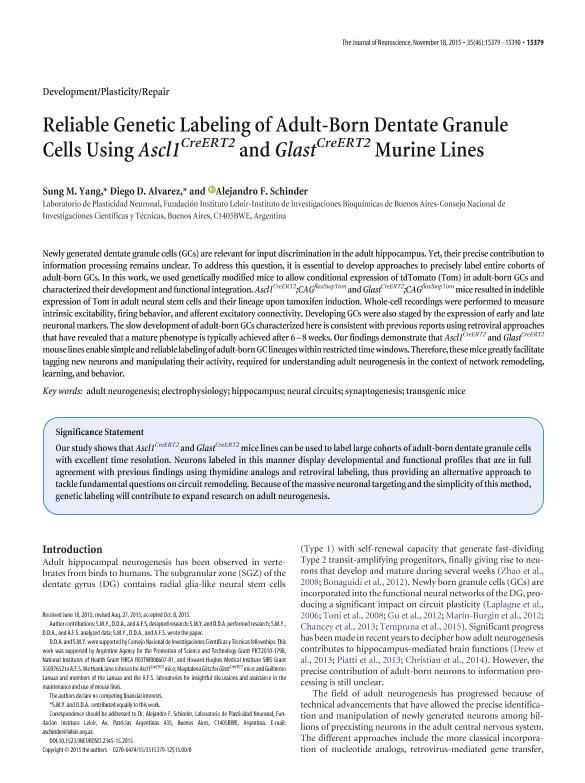Mostrar el registro sencillo del ítem
dc.contributor.author
Yang, Sung Min

dc.contributor.author
Alvarez, Diego

dc.contributor.author
Schinder, Alejandro Fabián

dc.date.available
2021-08-05T14:49:28Z
dc.date.issued
2015-11
dc.identifier.citation
Yang, Sung Min; Alvarez, Diego; Schinder, Alejandro Fabián; Reliable Genetic Labeling of Adult-Born Dentate Granule Cells Using Ascl1CreERT2 and GlastCreERT2 Murine Lines; Society for Neuroscience; Journal of Neuroscience; 35; 46; 11-2015; 15379-15390
dc.identifier.issn
0270-6474
dc.identifier.uri
http://hdl.handle.net/11336/137865
dc.description.abstract
Newly generated dentate granule cells (GCs) are relevant for input discrimination in the adult hippocampus. Yet, their precise contribution to information processing remains unclear. To address this question, it is essential to develop approaches to precisely label entire cohorts of adult-born GCs. In this work, we used genetically modified mice to allow conditional expression of tdTomato (Tom) in adult-born GCs and characterized their development and functional integration. Ascl1CreERT2;CAGfloxStopTom and GlastCreERT2;CAGfloxStopTom mice resulted in indelible expression of Tom in adult neural stem cells and their lineage upon tamoxifen induction. Whole-cell recordings were performed to measure intrinsic excitability, firing behavior, and afferent excitatory connectivity. Developing GCs were also staged by the expression of early and late neuronal markers. The slow development of adult-born GCs characterized here is consistent with previous reports using retroviral approaches that have revealed that a mature phenotype is typically achieved after 6–8 weeks. Our findings demonstrate that Ascl1CreERT2 and GlastCreERT2 mouselines enable simpleandreliable labeling of adult-bornGClineages within restricted time windows. Therefore, these mice greatly facilitate tagging new neurons and manipulating their activity, required for understanding adult neurogenesis in the context of network remodeling, learning, and behavior.
dc.format
application/pdf
dc.language.iso
eng
dc.publisher
Society for Neuroscience

dc.rights
info:eu-repo/semantics/openAccess
dc.rights.uri
https://creativecommons.org/licenses/by-nc-sa/2.5/ar/
dc.subject
ADULT NEUROGENESIS
dc.subject
ELECTROPHYSIOLOGY
dc.subject
HIPPOCAMPUS
dc.subject
NEURAL CIRCUITS
dc.subject
SYNAPTOGENESIS
dc.subject
TRANSGENIC MICE
dc.subject.classification
Otras Ciencias Médicas

dc.subject.classification
Otras Ciencias Médicas

dc.subject.classification
CIENCIAS MÉDICAS Y DE LA SALUD

dc.title
Reliable Genetic Labeling of Adult-Born Dentate Granule Cells Using Ascl1CreERT2 and GlastCreERT2 Murine Lines
dc.type
info:eu-repo/semantics/article
dc.type
info:ar-repo/semantics/artículo
dc.type
info:eu-repo/semantics/publishedVersion
dc.date.updated
2021-07-01T17:34:31Z
dc.identifier.eissn
1529-2401
dc.journal.volume
35
dc.journal.number
46
dc.journal.pagination
15379-15390
dc.journal.pais
Estados Unidos

dc.journal.ciudad
Washington
dc.description.fil
Fil: Yang, Sung Min. Consejo Nacional de Investigaciones Científicas y Técnicas. Oficina de Coordinación Administrativa Parque Centenario. Instituto de Investigaciones Bioquímicas de Buenos Aires. Fundación Instituto Leloir. Instituto de Investigaciones Bioquímicas de Buenos Aires; Argentina
dc.description.fil
Fil: Alvarez, Diego. Consejo Nacional de Investigaciones Científicas y Técnicas. Oficina de Coordinación Administrativa Parque Centenario. Instituto de Investigaciones Bioquímicas de Buenos Aires. Fundación Instituto Leloir. Instituto de Investigaciones Bioquímicas de Buenos Aires; Argentina
dc.description.fil
Fil: Schinder, Alejandro Fabián. Consejo Nacional de Investigaciones Científicas y Técnicas. Oficina de Coordinación Administrativa Parque Centenario. Instituto de Investigaciones Bioquímicas de Buenos Aires. Fundación Instituto Leloir. Instituto de Investigaciones Bioquímicas de Buenos Aires; Argentina
dc.journal.title
Journal of Neuroscience

dc.relation.alternativeid
info:eu-repo/semantics/altIdentifier/url/https://www.jneurosci.org/content/35/46/15379.long
dc.relation.alternativeid
info:eu-repo/semantics/altIdentifier/doi/http://dx.doi.org/10.1523/JNEUROSCI.2345-15.2015
Archivos asociados
